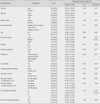Abstract
Purpose
The purpose of this study was to identify the levels of relocation stress syndrome (RSS) and influencing the stress experienced by Intensive Care Unit (ICU) patients just after transfer to general wards.
Methods
A cross-sectional study was conducted with 257 patients who transferred from the intensive care unit. Data were collected through self-report questionnaires from May to October, 2009. Data were analyzed using the Pearson correlation coefficient, t-test, one-way ANOVA, and stepwise multiple linear regression with SPSS/WIN 12.0.
Results
The mean score for RSS was 17.80±9.16. The factors predicting relocation stress syndrome were symptom experience, differences in scope and quality of care provided by ICU and ward nursing staffs, satisfaction with transfer process, length of stay in ICU and economic status, and these factors explained 40% of relocation stress syndrome (F=31.61, p<.001).
Conclusion
By understanding the stress experienced by ICU patients, nurses are better able to provide psychological support and thus more holistic care to critically ill patients. Further research is needed to consider the impact of relocation stress syndrome on patients' health outcomes in the recovery trajectory.
Figures and Tables
Table 2
Differences in Relocation Stress Syndrome by Socio-demographic and Illness-related Characteristics (N=257)

References
1. Baldwin FJ, Hinge D, Dorsett J, Boyd OF. Quality of life and persisting symptoms in intensive care unit survivors: Implications for care after discharge. Biomed Central Research Notes. 2009. 2(160):1–7.
2. Beard H. Does intermediate care minimize relocation stressfor patients leaving the ICU? Nursing in Critical Care. 2005. 10:272–278.
3. Carpentio LJ. Nursing diagnosis: Application to clinical practice. 2000. 8th ed. Philadelphia, PA: Lippincott.
4. Carr J. Griffiths RD, Jones C, editors. Ward visits after intensive care discharge: Why? Intensive Care After Care. 2002. Oxford: Butterworth & Heinemann.
5. Chaboyer W, Gillespie B, Foster M, Kendall M. The impact of an ICU liaison nurse: A case study of ward nurses' perceptions. Journal of Clinical Nursing. 2005. 14:766–775.
6. Coyle MA. Transfer anxiety: Preparing to leave intensive care. Intensive and Critical Care Nursing. 2001. 17:138–143.
7. Cutler L, Garner M. Reducing relocation stress after discharge from the intensive therapy unit. Intensive and Critical Care Nursing. 1995. 11:333–335.
8. Erdmann AJ Jr, Brodman K, Lorge I, Wolff HG. Cornell medical index health questionnaire: Outpatient admitting department of the general hospital. Journal of the American Medical Association. 1952. 149:550–559.
9. Field K, Prinjha S, Rowan K. 'One patient amongst many': A qualitative analysis of ICU patients' experiences of transferring to the general ward. Critical Care. 2008. 12:1–9.
10. Gustad LT, Chaboyer W, Wallis M. ICU patients' transfer anxiety: A prospective cohort study. Australian Critical Care. 2008. 21:181–189.
11. Jang YS. Development of admission and discharge criteria in intensive care unit. Journal of Korean Academy of Adult Nursing. 2001. 13:291–304.
12. Jenkins DA, Rogers H. Transfer anxiety in patientswith myocardial infarction. British Journal of Nursing. 1995. 4:1248–1252.
13. Koh CK. Patients' anxiety in intensive care units and itsrelated factors. Journal of Korean Academy of Nursing. 2007. 37:586–593.
14. Leith BA. Patients' and family members' perceptions of transfer from intensive care. Heart & Lung. 1999. 28:210–218.
15. McGuire BE, Basten CJ, Ryan CJ, Gallagher J. Intensive care unit syndrome: A dangerous misnomer. Archives of Internal Medicine. 2000. 160:906–909.
16. McKinney AA, Deeny P. Leaving the intensive care unit: A phenomenological study of the patient's experience. Intensive and Critical Care Nursing. 2002. 18:320–331.
17. McKinney AA, Melby V. Relocation stress in critical care: A review of the literature. Journal of Clinical Nursing. 2002. 11:149–157.
18. Nam HC. Study of Cornell's medical index: The third. Modern Medicine. 1965. 3:471–475.
19. Nunnally JC. Psychometric theory. 1978. New York, NY: McGraw-Hill.
20. Odell M. The patients' thoughts and feelings about their transfer from intensive care to the general ward. Journal of Advanced Nursing. 2000. 31:322–329.
21. Paul F, Hendry C, Cabrelli L. Meeting patient and relatives' information needs upon transfer from intensive care unit: The development and evaluation of an information booklet. Journal of Clinical Nursing. 2004. 13:396–405.
22. Roberts SL. Roberts L, editor. Transfer Anxiety. Behavioral concepts and theocratically ill. 1976. Englewood Cliffs, NJ: Prentice-Hall;224–253.
23. Son YJ. Development of relocation stress syndrome (RSS) scale for patients transferred from intensive care unit of general ward. Journal of Korean Clinical Nursing Research. 2008. 14:139–150.
24. Ssarmann L. Transfer out of critical care: Freedom or fear? Critical Care Nursing Qualiy. 1993. 16:78–85.
25. Strahan EH, Brown RJ. A qualitative study of the experiences of patients following transfer from intensive care unit. Intensive and Critical Care Nursing. 2005. 21:160–171.
26. Watts R, Gardner H, Pierson J. Factors that enhance or impede critical care nurses' discharge planning practices. Intensive and Critical Care Nursing. 2005. 21:302–313.
27. Watts R, Pierson J, Gardner H. An insight into critical care nurses' beliefs about the discharge planning process: A questionnaire survey. International Journal of Nursing Studies. 2005. 43:269–279.
28. Wesson JS. Meeting the informational, psychosocial and emotional needs of each ICU patient and family. Intensive and Critical Care Nursing. 1997. 13:111–118.
29. Whittaker J, Ball C. Discharge from intensive care: A view from the ward. Intensive and Critical Care Nursing. 2000. 16:135–143.
30. Yang JH. Experiences of admission for critically ill patientsin ICU. Journal of Korean Academy of Adult Nursing. 2008. 20:149–162.




 PDF
PDF ePub
ePub Citation
Citation Print
Print





 XML Download
XML Download